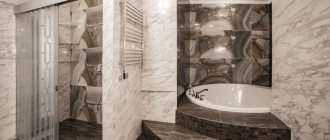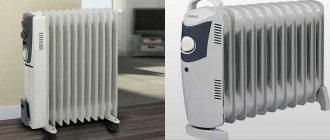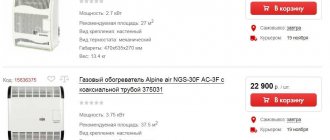The heating season usually begins strictly on schedule, even though the weather has been cool outside for a long time. Many people try to heat their homes with heaters. But they do not always manage to do this efficiently. After all, much of maintaining the desired temperature depends on the type of heater used. As observations show, some of the most popular types of climate control equipment are oil and infrared heaters. Since each of them has its own advantages and disadvantages, you should consider which heater is better - oil or infrared.
Operating principle and design of oil heaters
An oil heater is a metal case, inside of which there is a heating element and a container into which oil is poured. The heater consists of sections and looks like a regular radiator.
Attention: The area of the room heated by it directly depends on its power. That is, the more powerful the oil heater, the larger the area it can warm.
Oil radiators, despite their decent weight, are quite easy to move. This is possible due to the presence of wheels. In addition, since the heaters have a well-thought-out design, they take up little free space. Many models are equipped with a regulator that allows you to adjust the intensity of their work.
As practice shows, oil heaters are quite safe to use. They are equipped with a protection device against severe overheating. Thanks to the presence of a timer, it can automatically turn off when the room reaches the set temperature, and after a while, turn on independently. *The power of oil heaters may vary significantly depending on the model. In some heaters this figure is 3 kW. The area of the room heated by it depends on the power.
Your personal comfort and environmental friendliness
Since any heaters dry out the air, for an apartment with a small area it is better to choose the most gentle option. If you have allergies, do not lock yourself in a room with a convection fireplace running at full blast. Since air constantly circulates during the heating process, this prevents dust from settling. Consequently, it floats in the environment, and you will constantly inhale it.
Oil radiators do not circulate air, but can cause drafts due to uneven heating. For asthmatics or people prone to frequent colds, it is better not to use such a device.
To reduce the side effect of convection, use humidifiers or air ionizers, regularly do wet cleaning and ventilate the room. Sealed windows and tightly closed doors will help cope with drafts.
Advantages and disadvantages
The popularity of oil radiators is due to their many advantages, due to which the demand for them is often higher than for other similar products. Their advantages are:
- A high level of safety, which is achieved due to the fact that all heating elements are located in the housing. And the heating temperature of the case itself does not exceed 60 degrees. This design of the heater promotes fire safety and protects against burns that would be possible if accidentally touched.
- The duration of operation is associated with high-quality heater parts and its simple design. A good heater can operate continuously for 3 days.
- The noiselessness of oil heaters allows household members not to experience discomfort from its operation.
- The air in the room does not dry out, which allows the humidity to be within normal limits.
- Oil radiators are affordable for all segments of the population.
Despite the presence of numerous advantages, oil heaters also have some disadvantages that should be taken into account when choosing and purchasing them. The disadvantages of this heater are:
- Slow speed of achieving the desired temperature in the room. It takes approximately 30 minutes for high-quality heating. But this problem is not critical. There are models of heaters with a built-in fan, with the help of which you can quickly warm up a room.
- The considerable weight of the heater, which largely depends on the number of sections in it. But this drawback is not too big, since they are equipped with wheels for ease of movement.
From the above, we can conclude that an oil heater has many advantages that many other types of climate control equipment lack. And the shortcomings that it has are not critical.
Summary comparison table
For clarity, we summarize the above analysis in a table.
Table 1. Comparative characteristics of the converter heater and oil radiator expressed in numbers.
| Characteristics | Convector | Oil heater |
| Price | 4 | 5 |
| Life time | 5 | 3 |
| Efficiency | 4.5 | 5 |
| Room heating speed | 5 | 4 |
| Ease of use | 4.5 | 5 |
| Design | 4.5 | 3.5 |
| Safety | 5 | 4 |
| Additional functions | 4.5 | 5 |
| average rating | 4.63 | 4.31 |
The table provided, although not 100% objective, allows you to give a hint when answering the question: a convector heater or an oil heater, which is better to choose. Naturally, preferences may differ. But there are situations when the choice is obvious.
Right choice
*
If you intend to buy an oil heater, you need to carefully choose the right model. Be sure to consider the power of the device. It should be sufficient to heat the room. The required power should depend on the size of the room and the presence of windows and doors in it.
Attention: The quality of room heating also depends on the number of sections.
The more there are, the better you can warm the room. But at the same time, a large number of sections will negatively affect the weight of the heater.
The oil heater must be equipped with a thermostat, which is necessary to regulate the temperature and operating mode. Some heater models are additionally equipped with a timer, fan, clothes dryer, and remote control.
In general, oil heaters have proven themselves to be the best over the years of use. They allow you to efficiently warm the room and maintain the desired temperature for a long time.
Dimensions and appearance
When purchasing a heater for a country house, few people care about the compactness of the device - as long as it copes with the task assigned to it. Residents of small apartments are forced to take into account the size of fireplaces so as not to steal functional space from their home.
In terms of compactness and ease of placement, wall convectors win - they are flat and lightweight. Floor-standing ones won’t take up much space either. Oil radiators are more bulky and cannot be attached to the wall. In addition, not everyone likes the mass of such devices - when a heater weighs 20 kg, difficulties arise when moving from room to room, even with wheels.
As for the design, here I also give sympathies to convectors. They are laconic, discreet and fit into any interior. Moreover, wall-mounted models can be hidden behind mesh decorative grille panels.
Oil fireplaces are not distinguished by grace and beauty. Most of them look like a standard Soviet heater. But if you need to heat an average room, keeping it warm, and appearance is not important to you, then a radiator will be the best choice.
Infrared heaters
*
Infrared heaters are no less popular for heating various rooms. The demand for them is consistently high. They have the ability to heat not the entire room, but only certain areas. In addition, they are durable, economical and safe. Most often, IR heaters are used to heat private and country houses. But they are often used in apartments.
What is better to choose and in what case
The advantages of a convector are obvious, but the oil pan is better suited for the office. It is also purchased when there is a limited budget or the need for uniform heating. You can’t do without it in the garage either—extra dust doesn’t belong there. The device also fits well into the heating system of an apartment or house if additional heating is needed while the main heating is constantly running.
In other cases, a convector is preferable, especially at the dacha, where quick heating of the room is needed. Recommendations are not the ultimate truth - the choice in any case falls on the shoulders of the consumer.
Design
An infrared heater consists of a heating element, a quartz tube, a heat-emitting plate and an open spiral. When choosing this heater, you should pay attention to the following elements of its design:
- frame;
- foil;
- plate;
- insulator;
- heating element.
Much for high-quality heating depends on the plate. There should be no streaks on it. If they are present, then the rays emitted by the heater negatively affect the material from which it is made.
The plate must have an anodized layer with a thickness of at least 15 micron. If it is absent or less thick, the plate will quickly become unusable due to high temperature.
Much also depends on the material from which the body of the IR heater is made. It is best if it is made of aluminum or stainless steel. The heating element of the IR heater must be equipped with protection from exposure to moisture.
Radiators for water heating
They are used in permanent heating systems (centralized, autonomous). The heating process occurs with the help of a coolant circulating through the circuit. Unlike oil radiators, water radiators do not require power. Connecting a heating system with the latter to a gas boiler significantly reduces the cost of heating a home.
If thermostatic valves are installed on water radiators, it will be possible to set the required temperature in each individual room.
When choosing radiators for water heating, it is extremely important to pay attention to the material they are made from Source kermi.su
Pros:
- huge heat transfer;
- environmental friendliness;
- relatively high power.
Minuses:
- considerable cost;
- excessive heating of the case.
If water radiators are connected to a single heating system, then the temperature in all rooms of the house will be the same Source roomester.ru
Installation location
*
IR heaters are divided according to the installation location into the following types:
- ceiling;
- wall;
- floor;
- mobile.
The first three types of heaters are stationary. They do not take up free space and are distinguished by solid power and high efficiency. At the same time, mobile heating devices can be easily removed when not needed. In addition, they are significantly smaller in size than their stationary counterparts.
The most common IR heaters are ceiling-mounted. The heat-emitting element in them can be made of aluminum, glass, metal plates, anodized aluminum.
Attention: The most advanced and high-quality models are made of glass, as they are not capable of burning out.
But they also have a significant disadvantage - high cost. Products with an anodized aluminum plate are also in great demand. Among their advantages are strength, light weight and long service life.
Wall-mounted IR heaters are recommended to be installed under windows. This placement allows you to achieve high-quality and quick heating of the room.
Oil radiators
Heating devices radiate heat in different directions, creating a flow of warm air that is directed upward. As a result of this process, rapid heating of the room occurs.
Most often, oil radiators are used as additional heating units. The main way they differ from convector equipment is their large working area. Due to the circulation of hot mineral oil through the circuit, the entire surface of the radiator is heated. Such devices can be placed anywhere in the room (along the walls, under the table). There are also models designed for wall use only.
There is a heating element inside the oil cooler that warms up the oil, then it releases heat to the surrounding area Source gopb.ru
Pros:
- relatively fast heating of the room;
- mobility of the device;
- presence of built-in thermostats;
- simple maintenance;
- affordable price.
Minuses:
- there is a danger of getting burned due to the strong heating of the device, especially if there are small children in the house;
- Leaks may form in low-quality units;
- are used to produce only additional heat.
The oil radiator should not be left unattended - it is not intended for constant operation Source tehno-rating.ru
Wave Ranges
When choosing an infrared heater, you should pay attention to the length of the waves it emits during operation, which can be long, medium and short.
The most modern are long-wave heaters. When they operate, the heating element heats up to a temperature of no more than 250-350 degrees. This allows them to be fireproof and not dry out the air during operation.
*
Their heating element is made of an aluminum plate into which a low-temperature heating element is built. Most often, these models of climate control equipment are used for heating residential and industrial premises and offices.
Short-wave infrared heaters are most often used in workshops or outdoors. This is due to the fact that the waves they emit can negatively affect human health if he is regularly exposed to them. Because of this, it is not recommended to place them in residential premises or in crowded places.
Medium wave IR heaters are the most common. They are actively used for heating apartments, private and country houses, and offices. The varieties of these heaters according to the type of heating element are as follows:
- quartz;
- carbon;
- halogen;
- tubular;
- ceramic.
The best ones are carbon and tubular. With their help, you can quickly and efficiently heat the desired area of the room. Halogen ones should not be installed in residential areas, as they negatively affect well-being, and ceramic ones have a short service life.
Convector
The difference from an oil radiator can be noticed immediately, the shape of the body will be of a different type, this type of heating device is often hung on the wall, while oil samples are on the floor. The design is flatter, the smooth base contains a grille for the release of warm air, heated by a special element.
The package includes a room thermostat, thanks to which you can adjust the power of the equipment; radiation occurs only in the front part due to the movement of cold and hot air, this also applies to the differences between the device.
Design and principle of operation
During operation of the convector, warm air, passing through a heated spiral, rises, cold masses fall down for the next cycle. There is constant movement, and the unit cannot be called noisy. The room warms up quite evenly; you can often find such devices:
- In offices.
- Equipping production facilities.
- At home.
- Apartments.
There are floor-mounted versions; they are equipped with convenient wheels for moving around the rooms.
Advantages and disadvantages
The device is quite simple, it has its positive aspects, which primarily include rapid heating of the air. The noise level is reduced to “0”; the housing carefully hides the heating element, which prevents the risk of burns; this is worth considering when choosing a convector or oil radiator.
Energy is saved quite noticeably, but the maximum heat transfer rates are 60 degrees, while for the sample with a liquid container they range from 90-95 degrees. The cost of the equipment is slightly higher than that of the above-mentioned type of product; it will not be possible to find floor samples right away; such execution options are rare.
Which heater is better
Attention: In terms of its performance characteristics, an oil heater is more efficient than its infrared counterpart.
Thanks to its solid power, functionality and high efficiency, it can be used to efficiently heat any room. The cost of this climate control equipment is reasonable. It is safe, quiet and has a long service life. Despite its considerable weight, thanks to the presence of wheels, it is easy to move from place to place, and its shortcomings are not critical.
Comparison and conclusions
When comparing which is better, radiators or convectors, you should focus on operating conditions. Convectors provide uniform heating of rooms, but radiators are better because they cope with this task much faster. In turn, convectors benefit from safety and compactness. When it comes to electrical appliances, they are better due to faster and hassle-free installation. While water appliances benefit from efficiency - but only when using economical boilers.
Modern radiators and convectors, their distinctive features
Sectional and panel radiators are ordinary batteries operating on water coolant. They have minor design differences:
- Sectional heating devices are made of identical elements; with a small heat transfer, they can be expanded.
- Panel models are distinguished by greater heat transfer; the front shield hides the main coolant channel - a steel or copper tube. This is a one-piece device for heating a room; it cannot be increased in length, like a sectional model.
Panel heating radiator
However, their location is always standard - under windows, on walls.
As for convectors, they are easy to hide in the interior. You can place several air space heating units. They are:
- wall;
- basement;
- baseboards;
- floor;
- in-field.
The most common are floor-standing devices with 1 or 2 heat exchangers, easy to operate due to natural convection.
Wall heating convector
Hidden thermal blocks can be installed:
- inside the stairs;
- under the bars in the floor along the panoramic windows;
- in partitions for zoning;
- in niches and cabinets of cabinet furniture.
Convector plates inside the device provide rapid heat transfer due to the fact that when heated, the air expands and is pushed out with acceleration. This explains the special property of this variety. Such devices heat the entire volume of air much faster with little energy consumption.
The main differences between heating devices
Each outlet selling heating equipment offers a huge selection of models.
Floor heating convectors
They are classified (or distinguished) by a number of properties:
- power (thermal output, how quickly the room heats up);
- connection method (connection points to pipes for coolant inlet and outflow);
- type of assembly, solid or with the possibility of increasing length;
- body manufacturing metal (cast iron, steel, bimetal, aluminum or copper);
- safety of operation (low-quality products often burst when testing the system);
- maximum load (maximum pressure);
- equipment dimensions (length, height and depth);
- design (appearance, style);
- installation method (built-in, floor and wall, vertical and horizontal);
- type of energy resource (heating from a boiler or from the mains);
- the intended coolant (water and steam, antifreeze and oil) with its characteristic pH (acidity) level;
- economic benefit (cost and efficiency).
There is also a difference in mobility: a heating element, powered by an electrical outlet, warms up the oil inside the container - this is a mobile oil heater. But it can only serve as an additional source of heat.
Floor convector
Water and electric convectors also heat the air using the battery principle; the circulation of air masses around them occurs naturally or forcedly - through a built-in fan.











